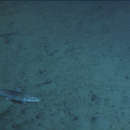Diagnostic Description
provided by Fishbase
This species is distinguished by the following set of characters (holotype measurements in parentheses): supraneural bones 6-7; dorsal-fin rays 54-65 (mode 58); total vertebrae 105-107 (107); pored lateral-line scales 99-109 (105); pre-dorsal scale rows 13-20 (16); head length 23-31 % (mean 27 %) of SL; pectoral-fin length 10-18 % (15 %) of SL; pre-dorsal-fin length 31-39 % (35 %) of SL; dorsal-fin base length 47-56 % (52 %) of SL; postorbital length 9-12 % (10 %) of SL; upper caudal-fin length 16-32 % (21 %) of SL (Ref. 109573).
- Recorder
- Estelita Emily Capuli
Life Cycle
provided by Fishbase
Spawning occurs in open waters. Eggs are pelagic (Ref. 205).
Morphology
provided by Fishbase
Dorsal spines (total): 0; Dorsal soft rays (total): 54 - 65; Analspines: 0; Analsoft rays: 10 - 13; Vertebrae: 105 - 107
- Recorder
- Estelita Emily Capuli
Trophic Strategy
provided by Fishbase
Found in deep waters.
- Recorder
- Grace Tolentino Pablico
Biology
provided by Fishbase
Found in deep waters.
- Recorder
- Cristina V. Garilao
分布
provided by The Fish Database of Taiwan
分布於西北太平洋區,包括日本、東海及臺灣。臺灣分布於東北部及東部海域等。
利用
provided by The Fish Database of Taiwan
罕見魚種。
描述
provided by The Fish Database of Taiwan
體頗延長而稍側扁,腹部圓。頭中等大,無鬚,黏液管發達。吻尖,可伸出。眼大,無眼瞼。口小,下位。齒細小而呈絨毛狀,上下頜各有1列齒,鋤骨及腭骨則不具細齒。體側被中等圓鱗,頭部則裸露,胸及腹部被鱗;腹鰭基部具1個長方形大腋鱗;側線發達,鱗數為107-113。單一背鰭,基底頗長,起始於胸鰭末端,止於臀鰭中部,鰭條數達58-65;無脂鰭;腹鰭起點稍前於背鰭中部基部的下方:臀鰭短小,接近尾鰭基部。體色銀白,背部略灰暗;各鰭灰色,背鰭具黑緣。
棲地
provided by The Fish Database of Taiwan
成魚發現於較深之沙泥底海域,棲息深度一般在300-500公尺間,最深可達1000公尺;幼魚期則發現於較淺水域。目前對於本魚種之生態習性不甚瞭解。
Japanese gissu
provided by wikipedia EN
Pterothrissus gissu, also known as the Japanese gissu, is a species of ray-finned fish in the family Albulidae.[3] The Japanese gissu is a rare fish that is distributed in deep water off northwest Pacific Ocean. This fish is known to pass through a leptocephalus larval stage, but only metamorphosed (after reaching the fully grown stage) specimens have been available.[4] This species is the only member of its genus.[1]
References
-
^ a b Hidaka, K., Tsukamoto, Y. & Iwatsuki, Y. (2016): Nemoossis, a new genus for the eastern Atlantic long-fin bonefish Pterothrissus belloci Cadenat 1937 and a redescription of P. gissu Hilgendorf 1877 from the northwestern Pacific. Ichthyological Research, 64 (1): 45–53.
-
^ Van Der Laan, Richard; Eschmeyer, William N.; Fricke, Ronald (11 November 2014). "Family-group names of Recent fishes". Zootaxa. 3882 (1): 1–230. doi:10.11646/zootaxa.3882.1.1. PMID 25543675.
-
^ a b Froese, R.; Pauly, D. (2017). "Albulidae". FishBase version (02/2017). Retrieved 18 May 2017.
-
^ Tsukamoto, Y. (2002): Leptocephalus larvae of Pterothrissus gissu collected from the Kuroshio–Oyashio transition region of the western North Pacific, with comments on its metamorphosis. Ichthyological Research, 49 (3): 267-269.

- license
- cc-by-sa-3.0
- copyright
- Wikipedia authors and editors
Japanese gissu: Brief Summary
provided by wikipedia EN
Pterothrissus gissu, also known as the Japanese gissu, is a species of ray-finned fish in the family Albulidae. The Japanese gissu is a rare fish that is distributed in deep water off northwest Pacific Ocean. This fish is known to pass through a leptocephalus larval stage, but only metamorphosed (after reaching the fully grown stage) specimens have been available. This species is the only member of its genus.
- license
- cc-by-sa-3.0
- copyright
- Wikipedia authors and editors

